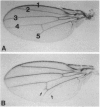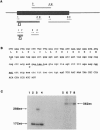Abstract
We present evidence that the JAK-STAT signal transduction pathway regulates multiple developmental processes in Drosophila. We screened for second-site mutations that suppress the phenotype of the hyperactive hopTum-1 Jak kinase, and recovered a mutation that meiotically maps to the known chromosomal position of D-Stat, a Drosophila stat gene. This hypomorphic mutation, termed statHJ contains a nucleotide substitution in the first D-Stat intron, resulting in a reduction in the number of correctly processed transcripts. Further, the abnormally processed mRNA encodes a truncated protein that has a dominant negative effect on transcriptional activation by the wild-type cDNA in cell culture. statHJ mutants exhibit patterning defects that include the formation of ectopic wing veins, similar to those seen in mutants of the epidermal growth factor/receptor pathway. Abnormalities in embryonic and adult segmentation and in tracheal development were also observed. The hopTum-1 and statHJ mutations can partially compensate for each other genetically, and Hop overexpression can increase D-Stat transcriptional activity in vitro, indicating that the gene products interact in a common regulatory pathway.
Full text
PDF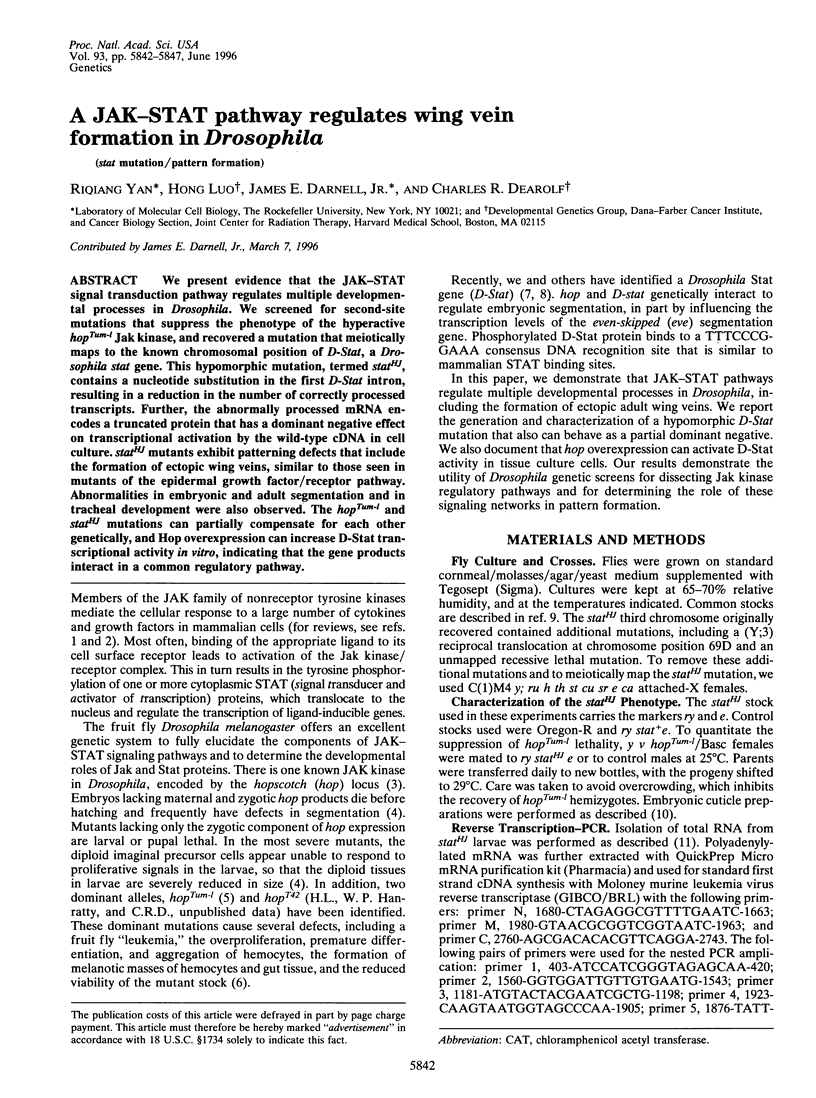
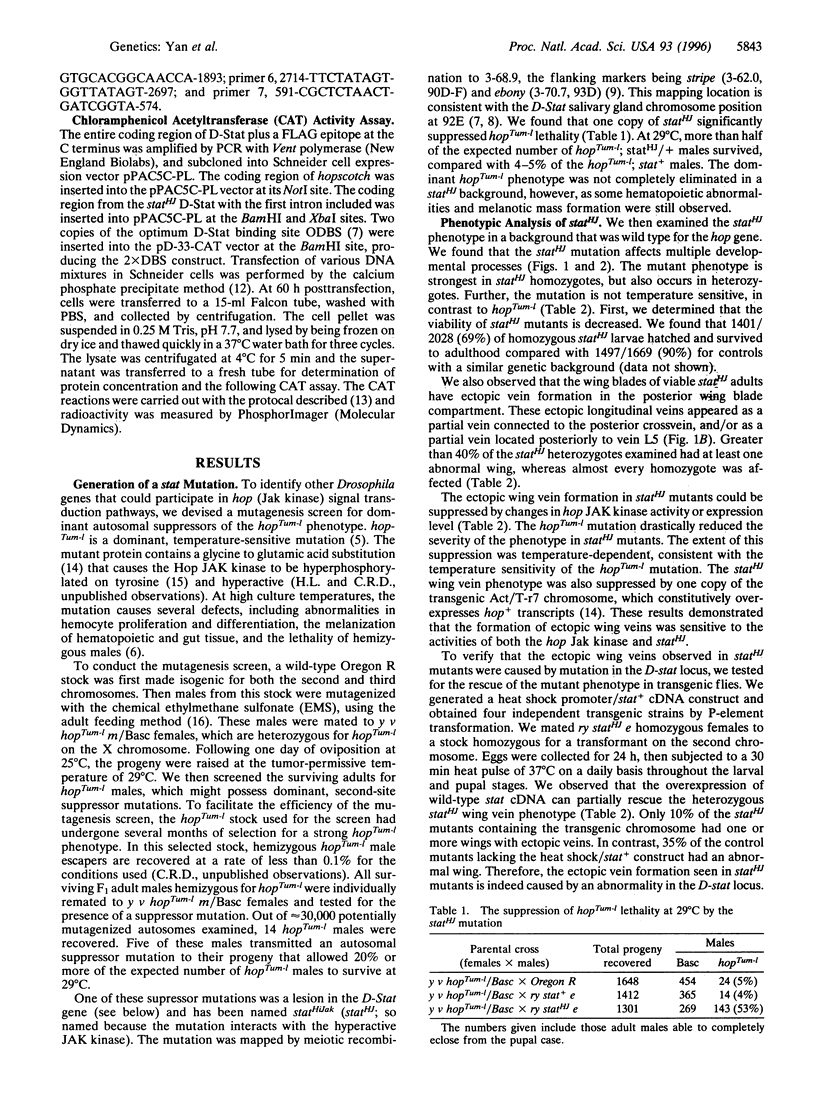
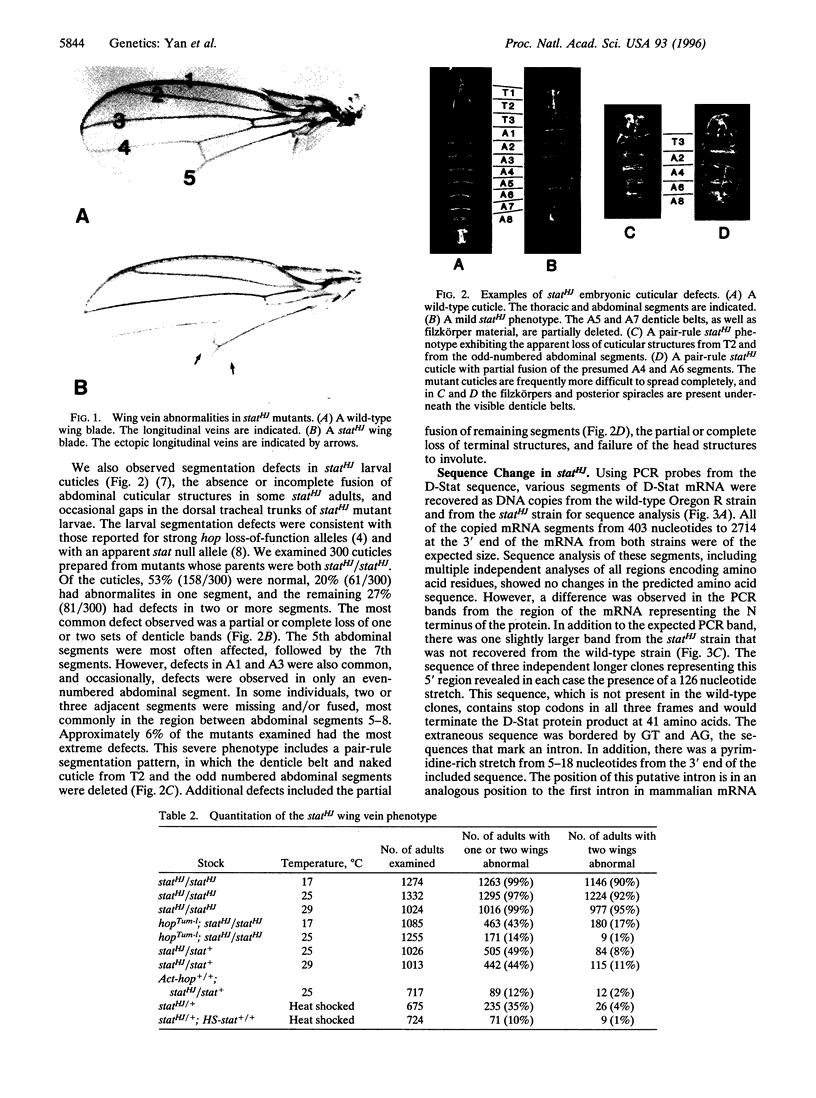
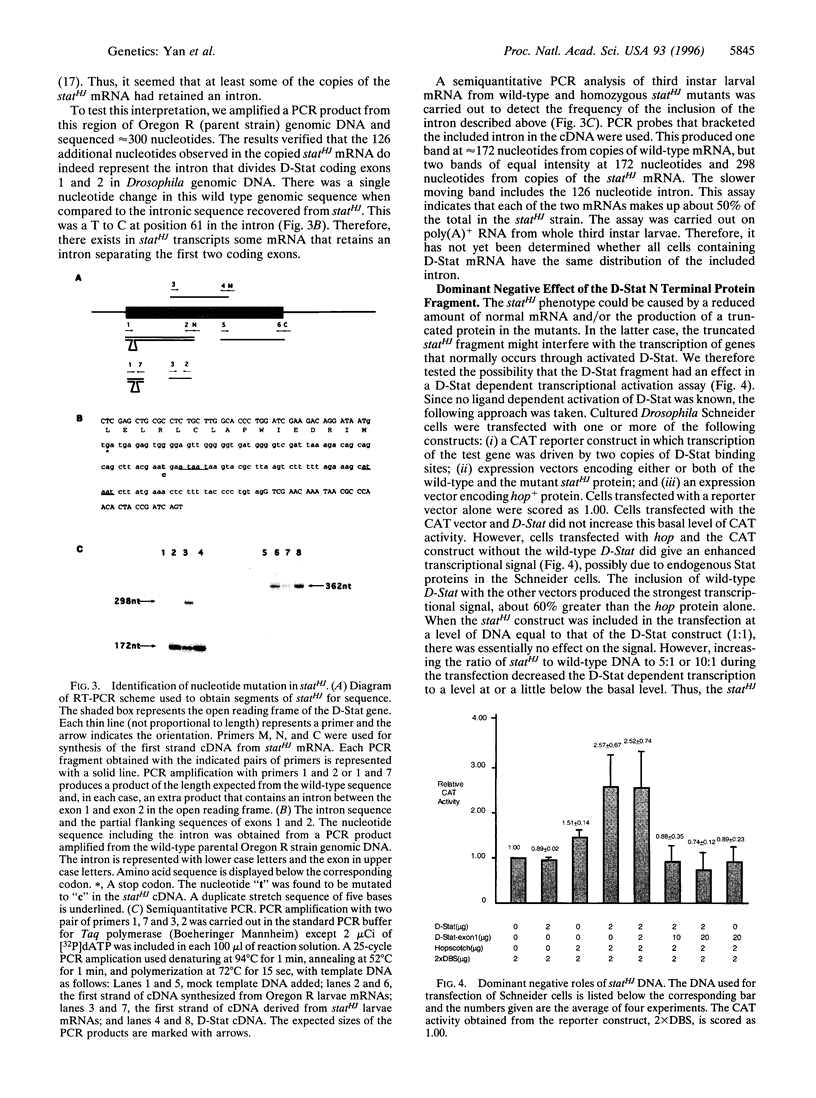
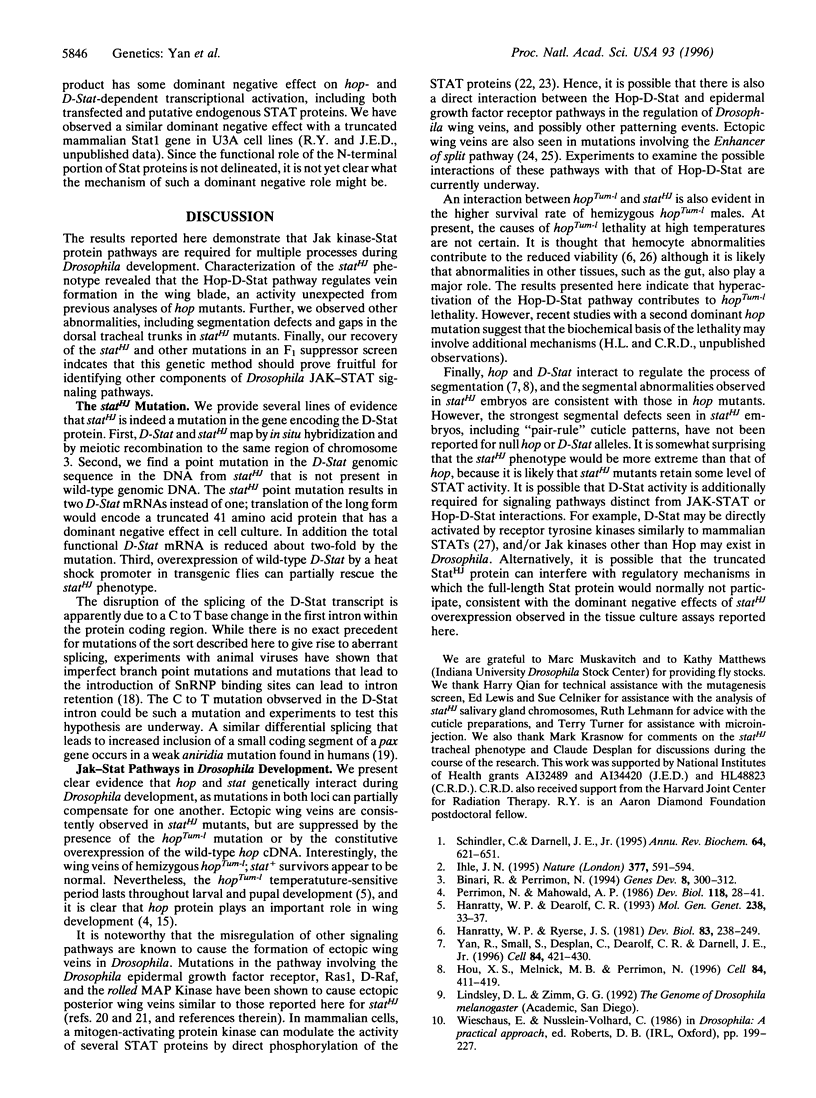
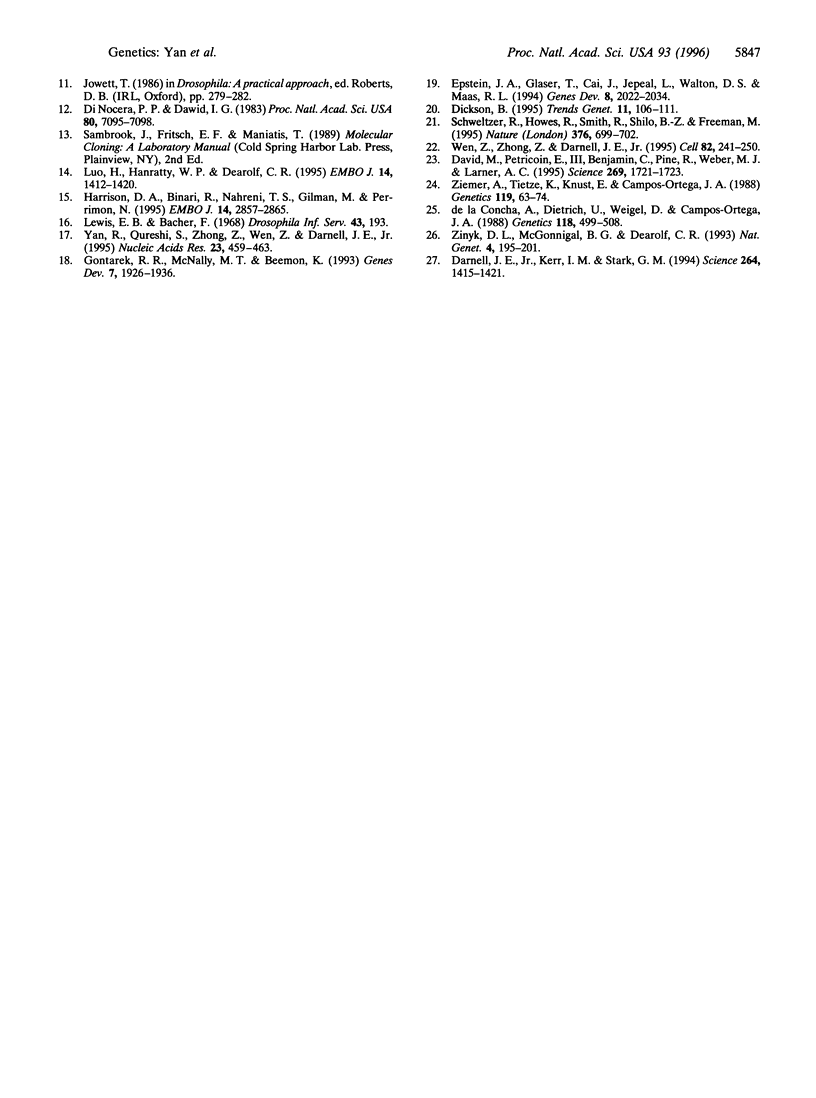
Images in this article
Selected References
These references are in PubMed. This may not be the complete list of references from this article.
- Binari R., Perrimon N. Stripe-specific regulation of pair-rule genes by hopscotch, a putative Jak family tyrosine kinase in Drosophila. Genes Dev. 1994 Feb 1;8(3):300–312. doi: 10.1101/gad.8.3.300. [DOI] [PubMed] [Google Scholar]
- Darnell J. E., Jr, Kerr I. M., Stark G. R. Jak-STAT pathways and transcriptional activation in response to IFNs and other extracellular signaling proteins. Science. 1994 Jun 3;264(5164):1415–1421. doi: 10.1126/science.8197455. [DOI] [PubMed] [Google Scholar]
- David M., Petricoin E., 3rd, Benjamin C., Pine R., Weber M. J., Larner A. C. Requirement for MAP kinase (ERK2) activity in interferon alpha- and interferon beta-stimulated gene expression through STAT proteins. Science. 1995 Sep 22;269(5231):1721–1723. doi: 10.1126/science.7569900. [DOI] [PubMed] [Google Scholar]
- Di Nocera P. P., Dawid I. B. Transient expression of genes introduced into cultured cells of Drosophila. Proc Natl Acad Sci U S A. 1983 Dec;80(23):7095–7098. doi: 10.1073/pnas.80.23.7095. [DOI] [PMC free article] [PubMed] [Google Scholar]
- Dickson B. Nuclear factors in sevenless signalling. Trends Genet. 1995 Mar;11(3):106–111. doi: 10.1016/S0168-9525(00)89011-3. [DOI] [PubMed] [Google Scholar]
- Epstein J. A., Glaser T., Cai J., Jepeal L., Walton D. S., Maas R. L. Two independent and interactive DNA-binding subdomains of the Pax6 paired domain are regulated by alternative splicing. Genes Dev. 1994 Sep 1;8(17):2022–2034. doi: 10.1101/gad.8.17.2022. [DOI] [PubMed] [Google Scholar]
- Gontarek R. R., McNally M. T., Beemon K. Mutation of an RSV intronic element abolishes both U11/U12 snRNP binding and negative regulation of splicing. Genes Dev. 1993 Oct;7(10):1926–1936. doi: 10.1101/gad.7.10.1926. [DOI] [PubMed] [Google Scholar]
- Hanratty W. P., Dearolf C. R. The Drosophila Tumorous-lethal hematopoietic oncogene is a dominant mutation in the hopscotch locus. Mol Gen Genet. 1993 Apr;238(1-2):33–37. doi: 10.1007/BF00279527. [DOI] [PubMed] [Google Scholar]
- Hanratty W. P., Ryerse J. S. A genetic melanotic neoplasm of Drosophila melanogaster. Dev Biol. 1981 Apr 30;83(2):238–249. doi: 10.1016/0012-1606(81)90470-x. [DOI] [PubMed] [Google Scholar]
- Harrison D. A., Binari R., Nahreini T. S., Gilman M., Perrimon N. Activation of a Drosophila Janus kinase (JAK) causes hematopoietic neoplasia and developmental defects. EMBO J. 1995 Jun 15;14(12):2857–2865. doi: 10.1002/j.1460-2075.1995.tb07285.x. [DOI] [PMC free article] [PubMed] [Google Scholar]
- Hou X. S., Melnick M. B., Perrimon N. Marelle acts downstream of the Drosophila HOP/JAK kinase and encodes a protein similar to the mammalian STATs. Cell. 1996 Feb 9;84(3):411–419. doi: 10.1016/s0092-8674(00)81286-6. [DOI] [PubMed] [Google Scholar]
- Ihle J. N. Cytokine receptor signalling. Nature. 1995 Oct 19;377(6550):591–594. doi: 10.1038/377591a0. [DOI] [PubMed] [Google Scholar]
- Luo H., Hanratty W. P., Dearolf C. R. An amino acid substitution in the Drosophila hopTum-l Jak kinase causes leukemia-like hematopoietic defects. EMBO J. 1995 Apr 3;14(7):1412–1420. doi: 10.1002/j.1460-2075.1995.tb07127.x. [DOI] [PMC free article] [PubMed] [Google Scholar]
- Perrimon N., Mahowald A. P. l(1)hopscotch, A larval-pupal zygotic lethal with a specific maternal effect on segmentation in Drosophila. Dev Biol. 1986 Nov;118(1):28–41. doi: 10.1016/0012-1606(86)90070-9. [DOI] [PubMed] [Google Scholar]
- Schindler C., Darnell J. E., Jr Transcriptional responses to polypeptide ligands: the JAK-STAT pathway. Annu Rev Biochem. 1995;64:621–651. doi: 10.1146/annurev.bi.64.070195.003201. [DOI] [PubMed] [Google Scholar]
- Schweitzer R., Howes R., Smith R., Shilo B. Z., Freeman M. Inhibition of Drosophila EGF receptor activation by the secreted protein Argos. Nature. 1995 Aug 24;376(6542):699–702. doi: 10.1038/376699a0. [DOI] [PubMed] [Google Scholar]
- Wen Z., Zhong Z., Darnell J. E., Jr Maximal activation of transcription by Stat1 and Stat3 requires both tyrosine and serine phosphorylation. Cell. 1995 Jul 28;82(2):241–250. doi: 10.1016/0092-8674(95)90311-9. [DOI] [PubMed] [Google Scholar]
- Yan R., Qureshi S., Zhong Z., Wen Z., Darnell J. E., Jr The genomic structure of the STAT genes: multiple exons in coincident sites in Stat1 and Stat2. Nucleic Acids Res. 1995 Feb 11;23(3):459–463. doi: 10.1093/nar/23.3.459. [DOI] [PMC free article] [PubMed] [Google Scholar]
- Yan R., Small S., Desplan C., Dearolf C. R., Darnell J. E., Jr Identification of a Stat gene that functions in Drosophila development. Cell. 1996 Feb 9;84(3):421–430. doi: 10.1016/s0092-8674(00)81287-8. [DOI] [PubMed] [Google Scholar]
- Ziemer A., Tietze K., Knust E., Campos-Ortega J. A. Genetic analysis of enhancer of split, a locus involved in neurogenesis in Drosophila melanogaster. Genetics. 1988 May;119(1):63–74. doi: 10.1093/genetics/119.1.63. [DOI] [PMC free article] [PubMed] [Google Scholar]
- Zinyk D. L., McGonnigal B. G., Dearolf C. R. Drosophila awdK-pn, a homologue of the metastasis suppressor gene nm23, suppresses the Tum-1 haematopoietic oncogene. Nat Genet. 1993 Jun;4(2):195–201. doi: 10.1038/ng0693-195. [DOI] [PubMed] [Google Scholar]
- de-la-Concha A., Dietrich U., Weigel D., Campos-Ortega J. A. Functional interactions of neurogenic genes of Drosophila melanogaster. Genetics. 1988 Mar;118(3):499–508. doi: 10.1093/genetics/118.3.499. [DOI] [PMC free article] [PubMed] [Google Scholar]



